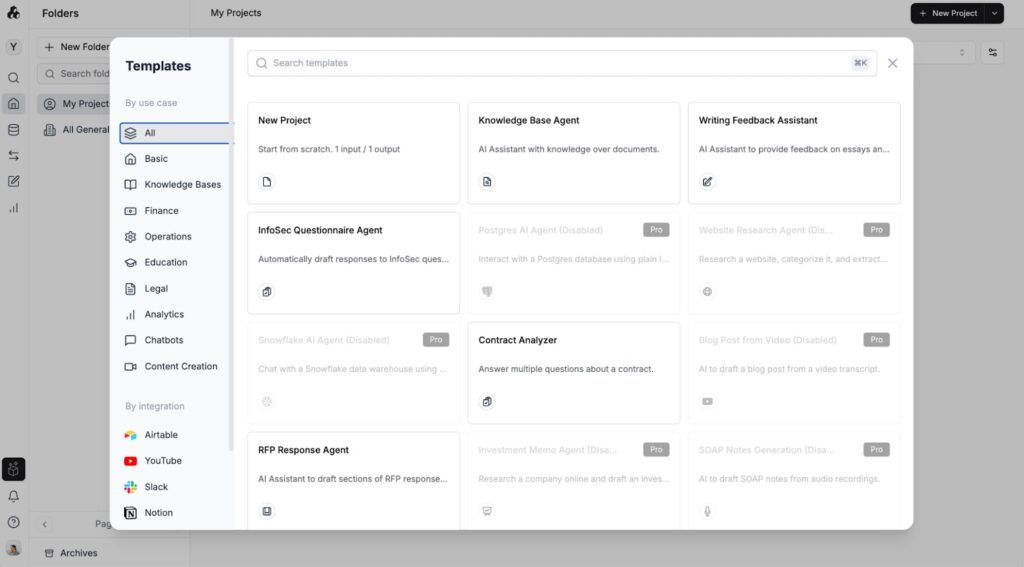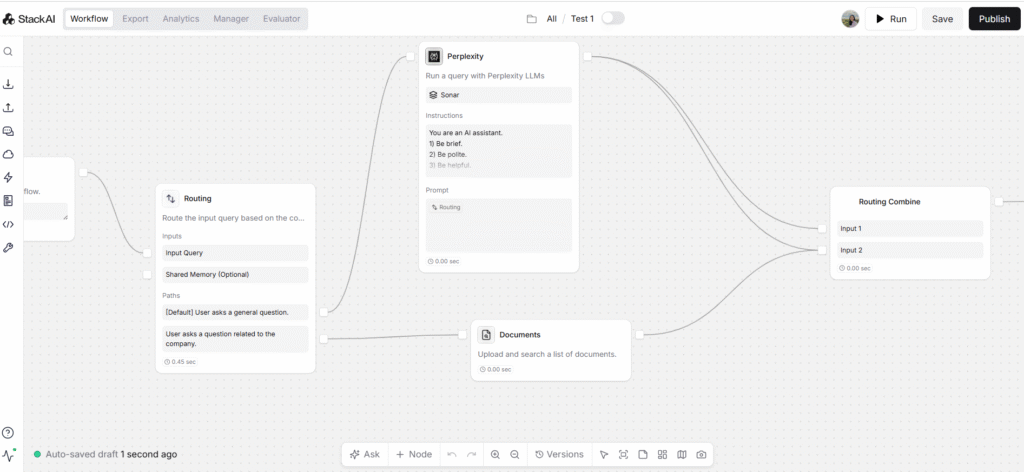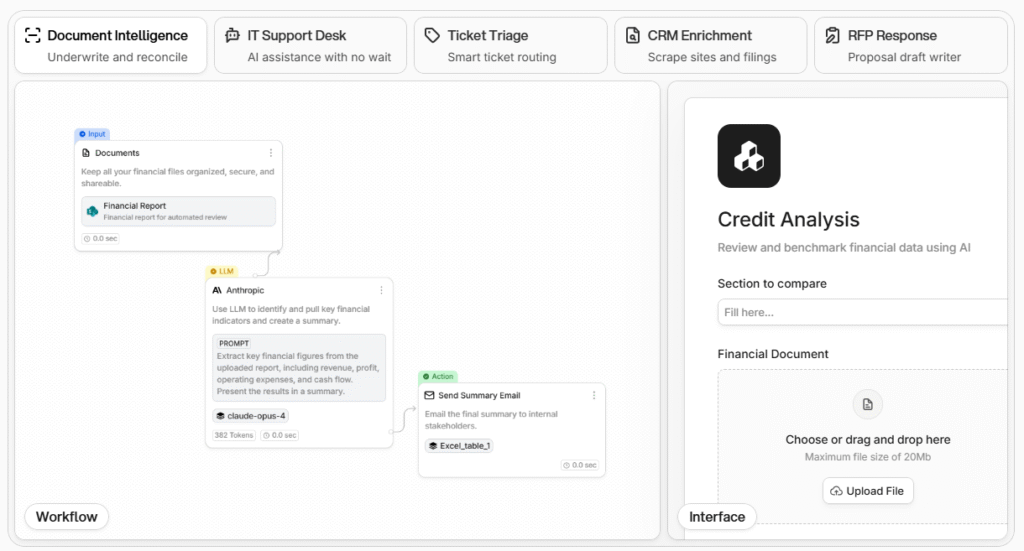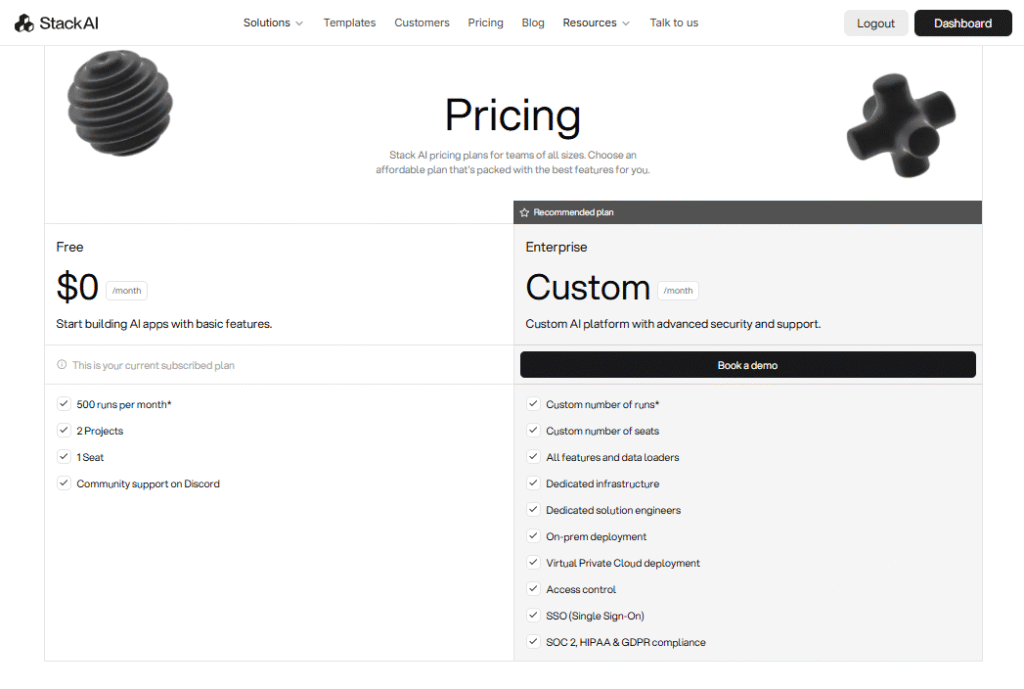Introduction to Stack AI
In a rapidly evolving business world where data and automation are crucial, Stack AI stands out as an enterprise-grade platform for building AI agents and workflows. Unlike many low-code/no-code automation tools that focus on startups or solo users, Stack AI is built specifically for large organizations needing robust, secure, and highly customizable AI-driven solutions.
If your company is dealing with complex, unstructured data scattered across multiple platforms, or you want to leverage AI to automate processes without hiring a team of machine learning engineers, Stack AI could be your ideal choice. On the other hand, if you are a solo founder or a small startup, Stack AI’s focus and pricing may not fit your needs.
TL;DR: Stack AI is an “AI assembly line” for enterprises, providing smooth drag-and-drop interfaces, hundreds of ready integrations, and strict security compliance. It lets business teams design, deploy, and scale AI-powered workflows without deep technical skills.

Founders, Background & Market Position
Stack AI was co-founded by Antoni Rosinol and Bernardo Aceituno, both MIT PhDs who identified the need for an enterprise-focused AI automation platform even before the ChatGPT boom. With early backing from notable investors like Y Combinator, Gradient Ventures, and Soma Capital, Stack AI quickly established itself as a trusted name in the enterprise AI landscape.
The platform boasts a rapidly growing client list, including HP, IBM, Red Bull, SmartAsset, LifeMD, Circle Medical, and HiveMQ. These aren’t just logos: many have adopted Stack AI to tackle real, mission-critical business challenges—from financial document automation to health record analysis and large-scale customer support.
Stack AI’s mission is clear: empower business teams to turn messy data into actionable, AI-powered workflows, with enterprise-grade security and ease of use at the core.
Key Use Cases: Where Stack AI Shines
My own projects—and those of industry peers—prove Stack AI isn’t just a theoretical platform. Here’s how it stands out in the wild:
- Financial & Insurance: Automate workflows like financial reporting, claims review, credit risk assessment, and fraud detection—all while maintaining complete data lineage and auditability.
- Education: Deploy custom AI assistants for student support, automate administrative tasks, or personalize learning at scale—no coding required for educators or program directors.
- Healthcare: Build “physician copilots,” extract histories from EHRs, or automate SOAP notes with full HIPAA compliance.
- AI/Marketing Agencies: Roll out white-labeled chatbots, automate onboarding, streamline content production, and serve end clients without ever writing code.
- Other Sectors: From legal (patent searches, compliance) and logistics (RFP automation, order triage) to HR (candidate evaluation, onboarding)—Stack AI adapts effortlessly.
One caveat: advanced marketing teams may note the current lack of a native Google Analytics integration. For everything else, the platform covers ground that most competitors cannot.
Core Features and User Experience
Agent Builder: Conversational AI Design
Stack AI’s Agent Builder is designed so anyone—regardless of coding skill—can create sophisticated AI agents just by describing what they want. You simply type in plain English, such as “Summarize all incoming customer emails and notify the support team if urgent,” and Stack AI quickly generates the foundational workflow for you. This natural language interface removes technical barriers and empowers business users to turn ideas into automation, fast.
What makes Agent Builder even more powerful is its extensive template library. If you’re new to workflow automation or just want to move fast, you can select from a wide variety of pre-built templates, including:
- Email triage bots
- Automated document extractors
- Customer support chatbots
- Financial report analyzers
- HR and onboarding assistants

Each template comes preconfigured with smart logic, common integrations, and best-practice flows. You can use them as-is for rapid deployment, or modify any step to fit your unique needs. This “head start” is a huge advantage for teams that want to avoid blank-canvas syndrome and see value on day one.
For more complex requirements, Agent Builder also offers full customization. You can add, remove, or rearrange workflow steps, integrate with any supported platform, and choose your preferred large language model—OpenAI, Claude, Gemini, Meta, or even your own private model.
Publishing your agent is also seamless: just one click to generate a unique link, share internally, or embed the agent into any tool your team already uses. This flexibility means every department—from marketing to HR—can quickly roll out tailored AI solutions without waiting on IT.
Workflow Builder: Visual Drag-and-Drop Automation
The workflow builder is where Stack AI’s drag-and-drop philosophy shines. You assemble your business process visually, connecting “nodes” for each action you need—whether that’s extracting text from a PDF, running a GPT-4 analysis, or pushing data into Salesforce.
Every step of the workflow can be customized.
- Need conditional logic? Just add an IF/ELSE node.
- Want to loop through a batch of files or trigger parallel actions? It’s just a few clicks.
Stack AI also offers a template library, so you don’t have to start from scratch. You can easily map data outputs from one step into another, making multi-stage automations straightforward and error-free.

Integrations & Model Support
Stack AI impresses with its massive library of 100+ out-of-the-box integrations. When you’re building a workflow, simply drag a node like Airtable, Google Calendar, or Slack onto the canvas, and Stack AI will instantly show you the available actions.
For example, with Airtable, a single drag-and-drop gives you the power to:
- Query data (using natural language, which is extremely convenient!)
- Create new records
- Update records
- Delete records
With Google Calendar, you can create events or automate reminders in just a few clicks. If you need Slack integration, your bot can read channel content, send automated messages, or query different channels—all within the same workflow.
The real strength is in “chaining” multiple integrations together. For example, your AI can read files from Google Drive, analyze the content using GPT-4 or Claude, fetch extra data from Snowflake, and update Salesforce—all in one seamless drag-and-drop workflow.
If a platform you need isn’t available out of the box, you can still connect it via MCP or a custom API, ensuring you’re never limited by Stack AI’s pre-built integrations.
This flexibility makes Stack AI a perfect solution for cross-department automation and data connection—whether for marketing, finance, operations, or customer support.
Deployment Interfaces & Branding
After building your workflow, Stack AI offers multiple ways to deploy your AI agents:
User Interfaces:
- Form: Great for structured input (data collection, onboarding).
- Chat Assistant: Standard chatbot experience.
- Website Chatbot: Easily embedded on your website.
- Batch Processing: Handle multiple files or documents at once.
API & Messaging Integrations:
- Slack/Microsoft Teams: Directly deploy into business communication channels.
- WhatsApp/SMS: Connect with customers on their preferred platforms.
- API: For developers wanting to embed workflows into their own products.
All chat interfaces are brandable and support custom data policies, ensuring data security and compliance.

Scalability & Security
Security and scalability are at the core of Stack AI:
- Deployment Options: Cloud, On-premises, VPC (Virtual Private Cloud), and self-hosted.
- Compliance: Certified for SOC2 Type II, HIPAA, GDPR, and has Data Processing Agreements (DPA) with major AI providers.
- Data Privacy: User data is not used for AI training.
- Role-based Access Control: Fine-grained permissions, SSO for Enterprise, and full audit logs.
Documentation, Learning & Support
Whether you’re a first-timer or an advanced user, Stack AI supports you with a comprehensive learning ecosystem.
The platform offers Stack AI Academy with video tutorials, hands-on guides, and industry-specific case studies.
In-product help is always at hand, with tooltips and context-aware suggestions to guide you step-by-step.
Free users can join the Discord community to ask questions and share experiences. Enterprise clients enjoy direct access to solution engineers, dedicated onboarding, and clear SLAs for support.
Stack AI regularly updates its changelog and documentation, so you’re always in the loop with new features and improvements.
Pricing & Usage Policy
Stack AI’s pricing is enterprise-focused and simple:
- Free Plan: $0/month, includes 500 runs per month, 2 projects, 1 user, and Discord community support—a generous trial tier for small teams or prototyping.
- Enterprise Plan: Custom pricing, offering unlimited runs, users, all features, advanced integrations, on-premise/VPC deployment, dedicated support, and compliance guarantees.
Some third-party sources mention “Starter” and “Team” plans ($199–$899/month), but these are not officially listed on the Stack AI website as of September 2025. Always check directly with Stack AI for the latest pricing.
Who should choose which plan?
- Free Plan: Ideal for early exploration, testing, and learning the platform.
- Enterprise Plan: For companies needing scale, security, integration, and support.

Pros and Cons of Stack AI
Before you jump in, here’s a quick rundown of Stack AI’s biggest strengths—and where it might fall short for some teams:
Pros
- Intuitive, modern drag-and-drop interface.
- Massive integration library (100+ connectors).
- Enterprise-grade security and compliance (SOC2, HIPAA, GDPR).
- Model-agnostic: supports all major LLMs and custom deployments.
- Robust documentation, templates, and onboarding support.
- Scalable from hundreds to millions of documents.
- Brandable interfaces and rich deployment options.
Cons
- No middle-tier pricing: Only free or custom enterprise plans.
- Lacks some marketing integrations (e.g., Google Analytics, social media scheduling).
- Potentially overkill for simple automation or small businesses.
- Free plan support is limited to community channels.
- Some integrations may require initial technical setup.
- Learning curve for advanced workflow logic.
Stack AI is a powerful, enterprise-grade solution that excels at complex, secure automation—especially for large organizations and regulated industries. While the pricing and learning curve may deter smaller teams, if you need scalable, flexible, and compliant AI-driven workflows, Stack AI is absolutely worth your shortlist.
Stack AI vs. Competitors
| Criteria | Stack AI | n8n | Gumloop | Vertex AI (Google Cloud) |
|---|---|---|---|---|
| Target User | Enterprise, business teams, non-tech users | Technical users, open-source community | Small agencies, marketing teams | Large enterprises, data science teams |
| Ease of Use | Modern UI, drag & drop, templates, no code needed | Requires technical setup, flowchart style | Very simple, template-focused | Developer-centric, complex UI |
| Integrations | 100+ native connectors, custom API support | 350+ nodes, mostly technical API integrations | Basic integrations, marketing tools | Google ecosystem, advanced APIs |
| AI-native Features | Built-in AI agent builder, supports multiple LLMs | Limited; requires manual API AI integration | AI chatbots, content tools | Powerful ML/AI tools, needs coding |
| Security & Compliance | SOC2, HIPAA, GDPR, role-based access, VPC/cloud | Depends on self-hosting and configuration | Relies on third-party hosting | Google-grade security, strong compliance |
| Pricing | Free (limited), Enterprise (custom), no mid-tier | Free (self-hosted), affordable paid cloud | Pay-as-you-go, affordable for small teams | Usage-based, pay-per-service |
Summary:
- Stack AI stands out for ease of use, business-user focus, and enterprise security, but lacks a mid-tier plan.
- n8n offers massive integrations and flexibility for tech teams, but isn’t “AI-native” and requires more setup.
- Gumloop is ideal for quick marketing/agency use cases, but less suitable for complex enterprise needs.
- Vertex AI is extremely powerful for organizations deep into the Google ecosystem and ML, but demands technical resources.
Conclusion: Should You Use Stack AI?
Stack AI is a top-tier solution for enterprises looking to unlock the value of AI with minimum friction and maximum security.
It empowers business teams to build, deploy, and iterate on complex AI workflows without waiting for scarce technical resources.
If you’re in a highly regulated industry (finance, healthcare, insurance), or manage massive unstructured data across many systems, Stack AI is a strong candidate to consider. For startups, freelancers, or simple automations, more lightweight platforms may be a better fit.
Ready to try?
Sign up for the generous Free plan to prototype your first agent, or contact the Stack AI team for a custom demo tailored to your use case.



